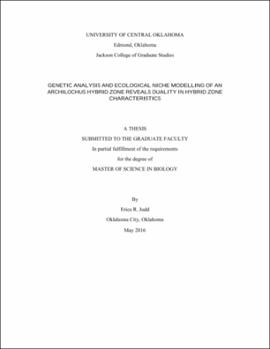| dc.contributor.advisor | Butler, Christopher | |
| dc.contributor.author | Judd, Erica R. | |
| dc.date.accessioned | 2020-07-09T14:39:17Z | |
| dc.date.available | 2020-07-09T14:39:17Z | |
| dc.date.issued | 2016 | |
| dc.identifier.other | (AlmaMMSId)9982462082502196 | |
| dc.identifier.uri | https://hdl.handle.net/11244/325031 | |
| dc.description.abstract | Two species of hummingbirds (Archilochus colubris and A. alexandri) whose breeding ranges and timing overlap in the great plains from south Texas to northern Oklahoma were hypothesized to produce hybrids in this area. Proposed hybrids had a gorget color that was intermediate between both parental species. In summer 2010 and 2011, during the breeding season, 200 Archilochus individuals were captured and feathers were taken for DNA analysis. The mitochondrial cytochrome oxidase 1 (CO1) gene was sequenced and 3 microsatellite markers were genotyped in order to identify hybrid individuals. Seventy-two unique haplotypes were identified in the sequence data, and phylogenetic trees constructed showed very close relationships among the haplotypes. Based on the difference between field identification and population assignment in Structure, 57 hybrids were identified (95% probability interval > 0.75). Their distribution was modeled using GARP, ENFA, and Maxent and an AUC measure of model accuracy indicated that GARP best represented the distribution of Archilochus hybrids (AUC = 0.94). Overall, a broad area of introgression was found to exist from west Texas to central Texas and central Oklahoma. This was farther west than expected because apparent hybrid males have only been documented as far west as Chickasha, OK. Recent expansion of Black-chinned Hummingbirds into Oklahoma suggests hybrid zone transience. However, the center of genetic diversity occurred in the older portions of the hybrid zone (Texas), and environmental variables predicted habitat suitability maps that were consistent with genetic data, which suggests bounded hybrid superiority. This duality indicates that hybrid zones fit different theories at different ages and dynamics. Future research should include multiple Archilochus specific microsatellites as well as sequencing additional mitochondrial genes to determine if a genetic cline exists across the US. | |
| dc.rights | All rights reserved by the author, who has granted UCO Chambers Library the non-exclusive right to share this material in its online repositories. Contact UCO Chambers Library's Digital Initiatives Working Group at diwg@uco.edu for the permission policy on the use, reproduction or distribution of this material. | |
| dc.subject.lcsh | Archilochus (Birds) | |
| dc.subject.lcsh | Hybrid zones | |
| dc.subject.lcsh | Microsatellites (Genetics) | |
| dc.title | Genetic analysis and ecological niche modeling of an Archilochus hybrid zone reveals duality in hybrid zone characteristics. | |
| dc.type | Academic theses | |
| dc.contributor.committeeMember | Haynie, Michelle L., 1975- | |
| dc.contributor.committeeMember | Hellack, Jenna | |
| dc.thesis.degree | M.S., Biology | |
| dc.subject.keywords | Archilochus | |
| dc.subject.keywords | Ecological Niche Modelling | |
| dc.subject.keywords | Great Plains | |
| dc.subject.keywords | Hybrid | |
| dc.subject.keywords | Microsatellites | |
| dc.subject.keywords | Sequencing | |
| dc.identifier.oclc | (OCoLC)ocn956509871 | |
| uco.group | UCO - Graduate Works and Theses::UCO - Theses | |
| thesis.degree.grantor | Jackson College of Graduate Studies. | |
